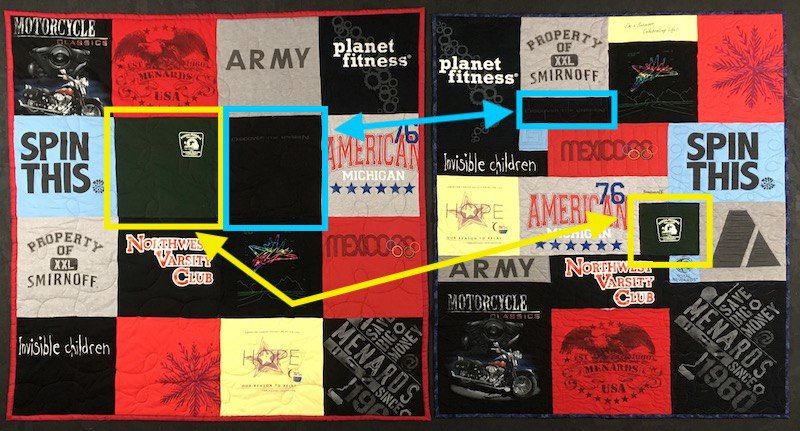Back to Top
Design of Quilt
The design of your quilt influences what your quilt will look like.

COMMENTS:
At Campus Quilts you either “have to” or “get to” design your own quilt. If you have the skill and knowledge to design your quilt, then you get to design it
But, what if you don’t have the background or knowledge to design your quilt? Then you “have to” design your own quilt.
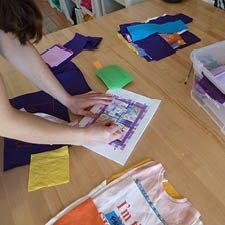
Some of the skills that you need to have is the ability to balance color. You also need to understand the direction of movement of your T-shirts. You need to know what might get cut off based on its location in the quilt.
Generally, most people are able to design their quilt well enough. After all, it is just a checker board. Dark, light, dark, light. But you many not feel comfortable with the design process.
At Too Cool T-shirt Quilts, we do this work for you. Our quilts are much more complex to design than a traditional style quilt. First, you need to figure the size out. Next, puzzle all the blocks into a map. Within the puzzle each specific block needs to be placed. Oh, don’t forget to balance the colors. And remember to consider the direction of the motion of the graphic. Plus, other design concerns.
Basically, these two styles of quilts are entirely different beasts. The Too Cool T-shirt quilt takes hours of work before we even begin sewing. Whereas Campus Quilts can go straight from cutting to sewing. Read more about the different styles of T-shirt quilts.
Backing Material
The backing is the fabric that goes on the back of your quilt or blanket. Below are the offerings of each company.

COMMENTS:
Backing Color Choices
T-shirt quilt companies can cut costs by offering a limited number of backing color choices. This is because they can order fabric in huge quantities at a discounted cost. They may not offer you the backing color that you would like. Campus Quilts offers 12 colors. Too Cool T-shirt Quilts offers over 250. Below is a panoramic photo of the fabric room at Too Cool T-shirt Quilts. 
Was the Backing Fabric Prewash?
This is important for two reasons.
First, most fabrics will shrink when initially washed. Unwashed fabric used in a quilt will shrink in the first wash. But the rest of the quilt won’t shrink. The result is a lumpy quilt. The material that doesn’t shrink has to go someplace. After the first wash, the back is smaller than the front. The material on the front and the batting has to go somewhere. That somewhere is up. Thus, your quilt is lumpy.
The other reason to prewash backing materials is to set the fabric dye. After fabric is washed, the excess dye should be washed out. Thus, the backing material will no longer bleed. If the backing material isn’t prewashed, guess what? The first time you wash your quilt it might come out pink! Or green or gray. (Think of the red sock in white laundry load.) The dye from the backing material might dye your quilt! At Too Cool T-shirt Quilts we make sure we set the backing material’s color so it won’t bleed.
Material Quality
Campus Quilts uses a low-quality fabric on the back of their quilts. First, it was scratchy feeling. And second, you could feel the poor quality of the fabric. It feels cheap. On their website, it does say 100% cotton. But that doesn’t mean it’s a high-quality fabric.
At Too Cool T-shirt Quilts we use 100% cotton high quality fabric. This does cost more than cheap material. The price difference per yard could be over $4 a yard. That is a lot considering a quilt uses between 4 and 9 yards of fabric.
Issues with the backing color?
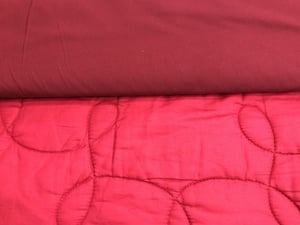 We did have issues with the backing color of the Campus quilt. We had chosen crimson. Crimson is a dark red color. When we received the quilt, the color turned out fuchsia pink. We had ordered this dark red for a guy. It came back in the pink family. The guys here at Too Cool T-shirt Quilts said they wouldn’t use a pink quilt.
We did have issues with the backing color of the Campus quilt. We had chosen crimson. Crimson is a dark red color. When we received the quilt, the color turned out fuchsia pink. We had ordered this dark red for a guy. It came back in the pink family. The guys here at Too Cool T-shirt Quilts said they wouldn’t use a pink quilt.
In the photo here, the top color is crimson. It's a dark maroon-red. The bottom color is the campus quilt with the "crimson" backing color. What do you think?
Batting
Although you don’t see the batting in a quilt, it is very important. The type and quality influences the longevity of a quilt.
Comments:
Batting Type
 One of the things we were most surprised by was Campus Quilt’s batting choice. They use one of the cheapest battings on the market. It is a high loft 100% polyester batting. The loft is very high, meaning that the quilt is very thick. This batting will begin to lump-up after the first wash.
One of the things we were most surprised by was Campus Quilt’s batting choice. They use one of the cheapest battings on the market. It is a high loft 100% polyester batting. The loft is very high, meaning that the quilt is very thick. This batting will begin to lump-up after the first wash.
Bearding is an additional issue with this batting. Bearding is when the polyester fibers pop through the backing material. It gives the back of a quilt a faint hairy look. What’s happening? The polyester fibers are falling away from the batting. They then travel through the backing of your quilt. We could see this on the back of our new Campus Quilt.
Too Cool T-shirt Quilts uses a batting made by Hobbs Bonded Fibers of Waco, Texas. The batting is 80% cotton and 20% polyesters. This batting is special because it is needle punched.
Needle punching locks the cotton fibers together. They run the batting though a roller of hot needles. As the needles goes into the batting, they melt the polyester fibers. As the needles exit the batting, the hot polyester is dragged up through the cotton fibers. This is what bonds the cotton fibers together. This makes for a very stable cotton batting. It is difficult to tear, and it doesn’t bunch up.
Quality
100% high loft polyester batting is at the low end of the quality spectrum. Needle punched cotton/poly is at the opposite end of the spectrum.
Durability
100% high loft polyester batting bunches up over repeated washings. Eventually, your quilt will have lumps of batting and areas without batting.
The needled punched cotton batting is tough stuff. It’s difficult to tear. It stays where you put it. It will last.
Loft or Batting Thickness
People tend to equate batting thickness to warmth. They assume that a thick batting is warmer than a thin batting. But this is untrue. Batting technology has made it so that a thin cotton batting is warm. They can be as warm or warmer than a thick polyester batting.
The thickness of this batting will affect your quilt. A thick batting makes it difficult to fold and store your quilt. The thick batting will also bunch up after you wash your quilt. Any skilled quilter wouldn’t choose such a batting for their quilt. They know to avoid that trouble.
This is kind of a strange photo. It was taken at the level of the quilt. It shows that on the right, the Campus Quilts quilt is much more puffy than the Too Cool on the left.

Washing Directions
You should use and enjoy your T-shirt quilt. This means that it will get dirty and need washing. Below are the washing directions for each company.

Comments:
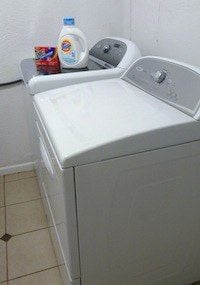
When we opened the box from Campus Quilts, we were dumbfounded! Because the first thing we read was, “Dry Clean Only.” Are you kidding?!? Who dry-cleans a T-shirt quilt?
But after looking at and feeling the quilt, we knew why. The one big reason is: Campus Quilts doesn’t prewash their backing material. So, they tell you that you must dry-clean your quilt. And if you wash it? They aren’t liable for what happens to your quilt. After all, they told you to dry-clean your quilt.
This is what will happen:
- The backing material will shrink. The result? The backing material is now smaller than the quilt top and batting. The quilt top and batting can no longer lay flat and will bunch up.
- The backing material may bleed. When the backing material bleeds, the dye will stain the front of your T-shirts.
So, how do we know this?
We had two Campus Quilts arrive at our shop on the same day. We received our quilt from Campus Quilts. We also received another Campus Quilt. A new customer had sent us her Campus Quilt to have remade into a Too Cool T-shirt Quilt.
This allowed us to dissect a Campus Quilt. We played with one section of the quilt that our customer didn’t want used. We sewed the raw edges of that section closed. We washed it. That’s how we know.
Want to learn more about T-shirt quilts? Visit our Learning Center.
We have over 200 articles about all aspects of T-shirt quilts.
Quilting
The quilting on a quilt holds the front, the batting and the backing together. If the three layers are not held together, the batting will bunch up and be lumpy.
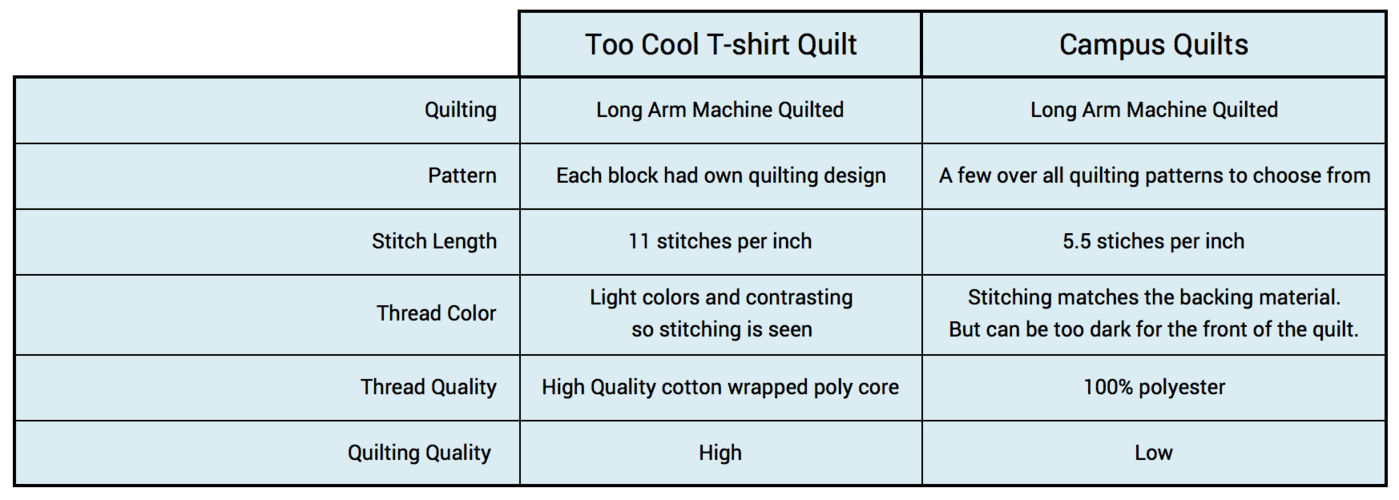
Comments:
Quilting
Both Campus Quilts and Too Cool T-shirt Quilts use similar long-arm quilting machines. We know this because we both purchase our machines from the same dealer. But the quilting on the two quilts couldn’t be more different. Below are some of the differences.

Pattern
Campus Quilts offers a few quilting pattern choices. For example, loops or a meandering pattern. The quilting is spaced very far apart. There were only 5 rows of quilting on our quilt. This left large areas not quilted. This will lead to the batting coming apart and bunching up. We had expected more quilting than that. The quilting also started and stopped in from the edge of the quilt.
Each block in a Too Cool T-shirt Quilt is quilted with its own unique pattern. The quilting is close, leaving only small areas on the quilt without quilting. Read more about Quilting a T-shirt quilt here.
Stitch Length
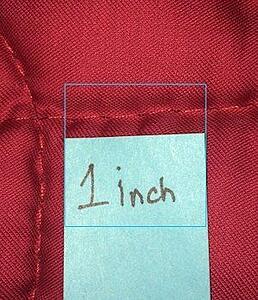
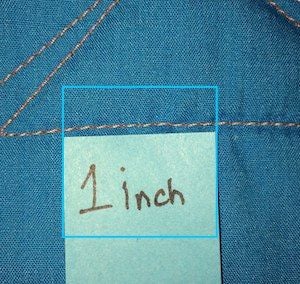 The industry standard for stitches per inch ranges between 10 and 12 stitches per inch.
The industry standard for stitches per inch ranges between 10 and 12 stitches per inch.
Campus Quilt’s stitch length is 5.5 stitches per inch. This means that the stitches are extremely long. We were curious about exactly how long the stitches are.
So, we did a test on our standard sewing machines. We set the stitch length to “basting.” A basting stitch temporarily hold layers of fabrics together until they’re permanently stitched. It’s meant to be temporary and removed later. Our machine’s basting stitch was 5.5 stitches per inch.
So, Campus Quilts uses a basting stitch when they quilt. Why? Because it is faster. By speeding up the process, they can earn more per quilt. This is good for them. But not for you. The result is bunched up batting and stitches that can easily come out.
Too Cool T-shirt Quilts uses 11 to 12 stitches per inch. We have more stitching in one block than Campus Quilts has in their entire quilt.
Thread Color
Campus Quilts matches their thread color to their backing material. A quilter matches thread color with the backing material to hide or down play the quilting. And since Campus Quilts doesn’t emphasize their quilting, this makes sense.
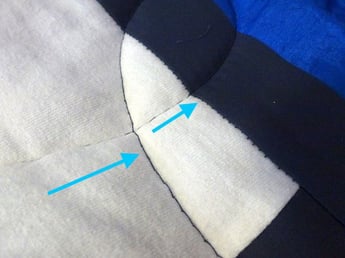
There’s a problem with matching the quilting thread to the backing color on a T-shirt quilt. This happens when using dark backing colors. Thread matching dark backing material might be too dark on the front of the quilt.
Too Cool T-shirt Quilts uses lighter colored thread on our quilts. First, we generally don’t like how dark thread looks on the T-shirts. Especially on white T-shirts. Most of the time it looks poor. We made one quilt using navy blue thread. It looked terrible.
The photograph here shows two issues with a Campus Quilt and stitching. First, the navy stitching on the white T-shirts looks poor. The top arrow points to the seam where the stitching is pulling open.
We tend to use lighter colored threads for our quilting. We like how light-colored threads contrast with the backing material color. We like how this emphasizes the quilting.
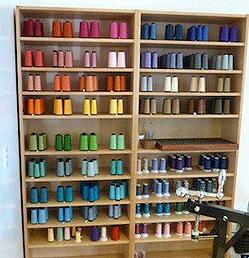
Thread Quality
When we tore apart that Campus Quilt for our customer we were in for a surprise. We quickly discovered that the thread they used was rayon. The thread frayed and fell apart. The advantage of rayon is that it is soft and inexpensive. The disadvantage is that it is often not colorfast. It’s not as strong and less durable than other types of threads.
Too Cool T-shirt Quilts uses cotton or cotton-wrapped polyester threads. These threads are durable, strong and colorfast. And yes, more expensive.
Binding Style
On a quilt, a binding covers the raw edges of the quilt’s three layers.

Comments:
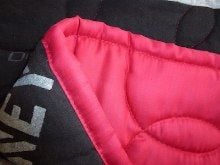 Half Binding
Half Binding
Campus Quilts uses a half binding style. In a half binding, the backing fabric is then folded around to the front of the quilt. It is then top-stitched down. There are three issues with a half binding:
- The binding is only one layer thick on the edge.
- You cannot have a contrasting binding color. The color is the same as the back of your quilt.
- The quilting cannot extend on to the edge of the quilt.
Full Binding
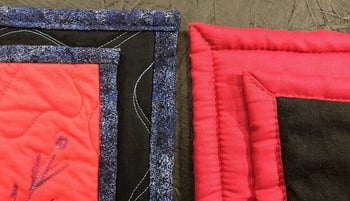
Too Cool T-shirt Quilts uses a strip or full binding style. A quilter sews this binding onto the quilt in two steps. First, they cuts a strip of binding. Then they folds the strip in half length-ways. The quilter sews this strip to the edge of the quilt working from the front of the quilt.
In the second step, the quilter folds the binding over to the back of the quilt. Then they sews the strip to the back by sewing from the front of the quilt. This is a blind seam. It takes years of practice to do perfectly.
A full binding allows for:
- The binding to be two layers thick.
- Contrasting color options.
- The quilting can extend to the edge of the quilt.
A half binding is quick, does not request additional fabric and the sewer needs less experience. Therefore, it is a cost savings for the quilt maker. Read more about bindings here.
Transactions and Cost
Here’s a breakdown of the cost of each quilt. We also compare the transactions of purchasing a quilt from each company. Note, these prices where from when this comparison was made. The percentage cost difference is still about the same.
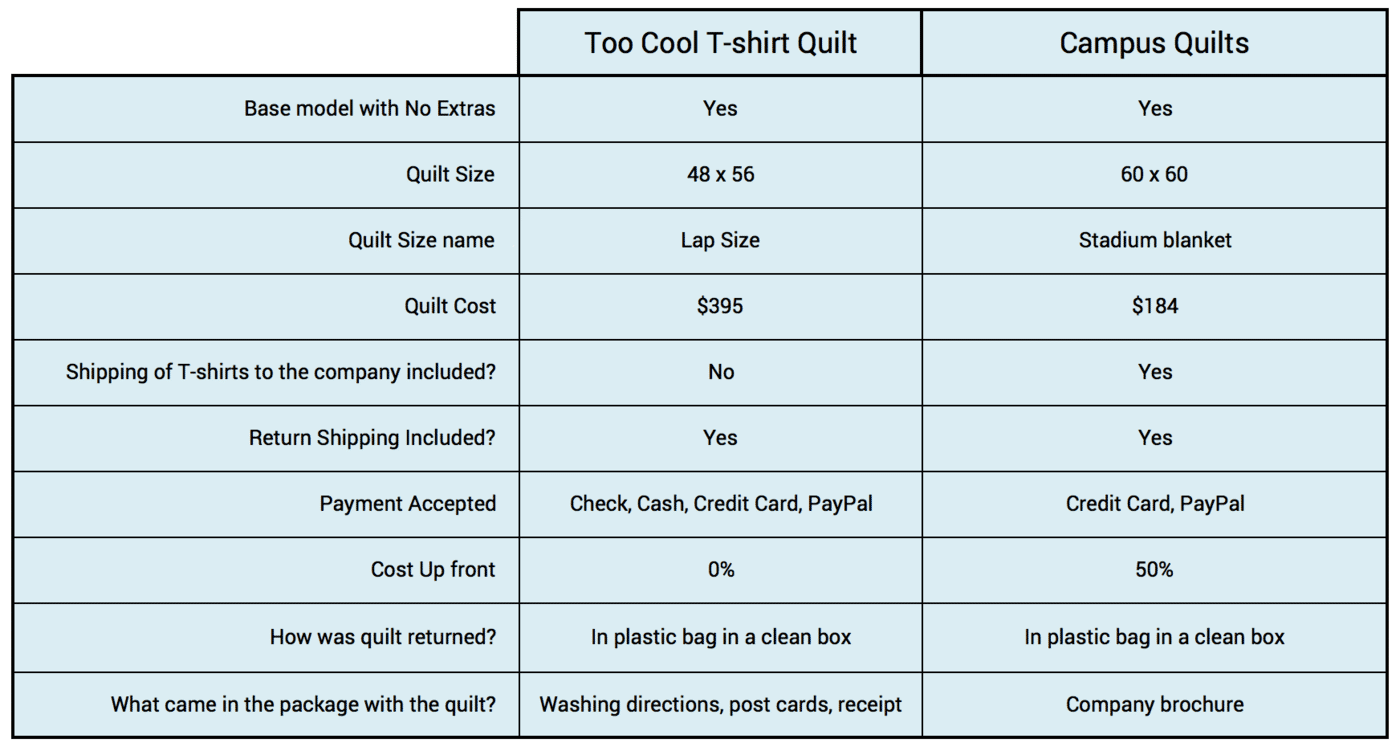
Comments:
Cost
A Campus Quilt is half the cost of a Too Cool T-shirt quilt. They also pay for shipping your T-shirts to their company.
So why the big cost difference?
Campus Quilts and Too Cool T-shirt Quilt both make T-shirt quilts. But that’s where the similarities end. The two companies make very different product.
- Number of T-shirts used: different!
- Style of quilt: totally different!
- Material quality: high vs. low.
- Washing directions – washable vs. not washable.
- Quilting – night and day!
- Binding style –one step vs. two step.
- Overall – heirloom vs good enough.
You have T-shirts and you want a quilt. You have to decide what you want your quilt to look and feel like. The choice is yours.
Video Comparison
Complete Comparison Chart
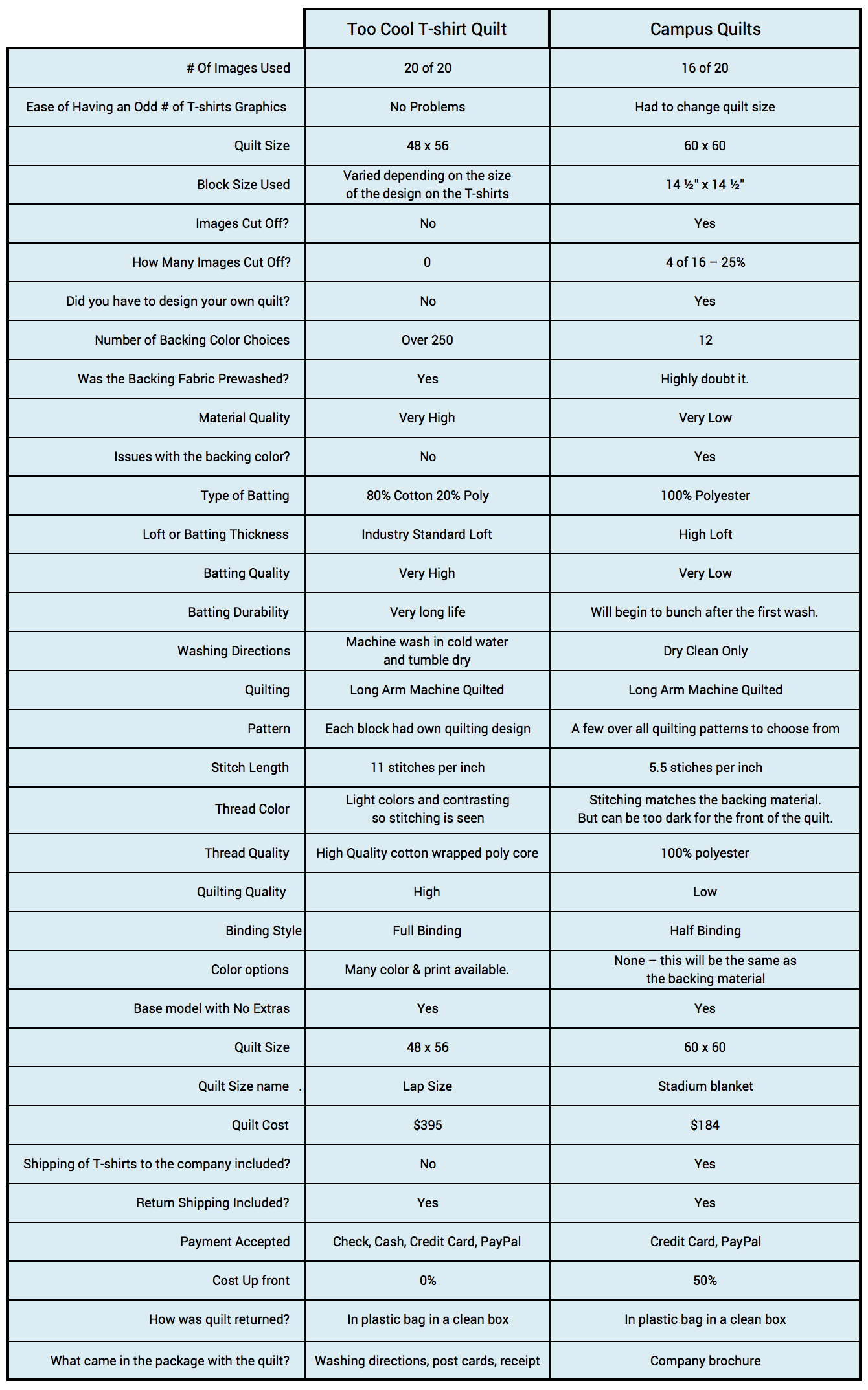
Planning a T-shirt quilt?
Here are step-by-step directions for ordering your Too Cool T-shirt quilt.

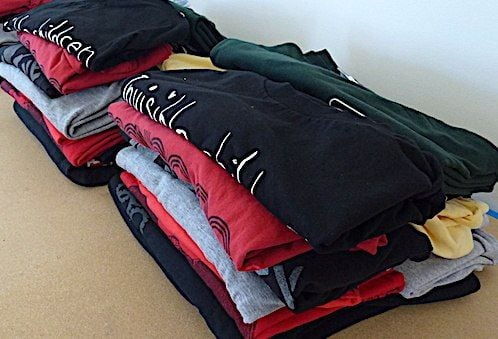
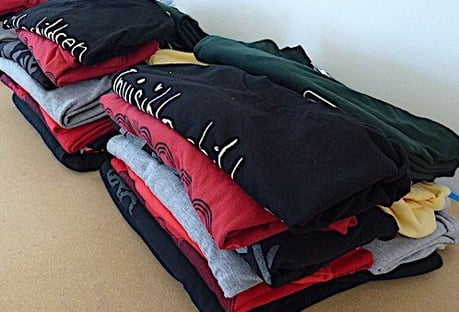 We collected 2 groups of 15 identical T-shirts. We chose T-shirts that would represent many different styles and types of T-shirts. This included T-shirts with large and small designs. The groupings had T-shirts with graphics on the front, back and sleeves. A sweatshirt, a very thin T-shirt and a child size T-shirt were also included in the mix.
We collected 2 groups of 15 identical T-shirts. We chose T-shirts that would represent many different styles and types of T-shirts. This included T-shirts with large and small designs. The groupings had T-shirts with graphics on the front, back and sleeves. A sweatshirt, a very thin T-shirt and a child size T-shirt were also included in the mix.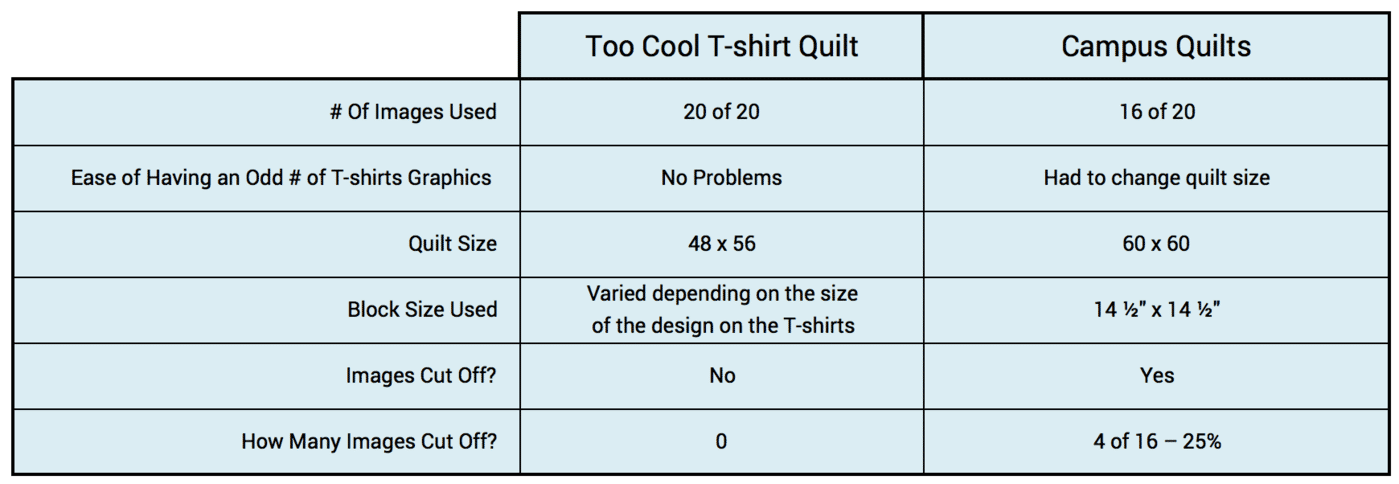
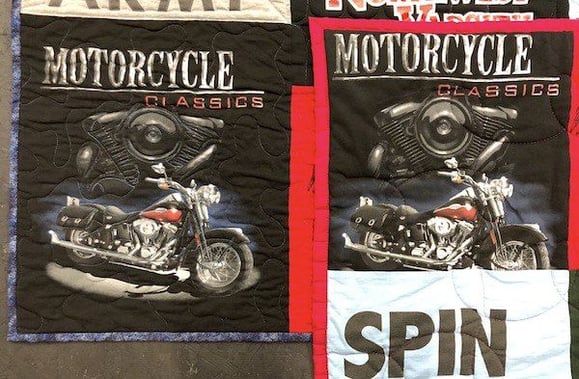 Not all T-shirts have the same size graphics. What happens if you cut all your T-shirts with the same size block? The graphics on your T-shirt will either:
Not all T-shirts have the same size graphics. What happens if you cut all your T-shirts with the same size block? The graphics on your T-shirt will either: